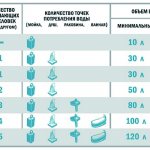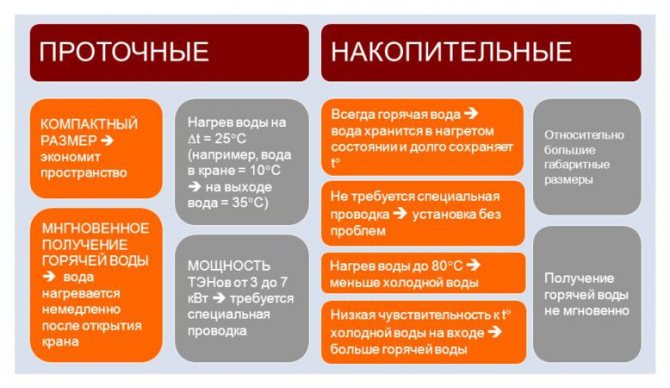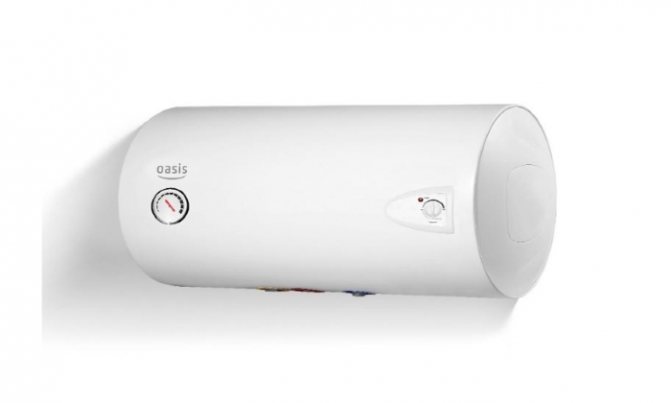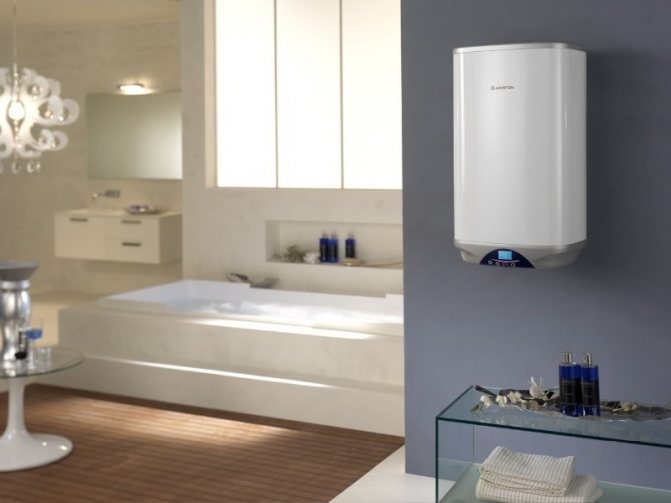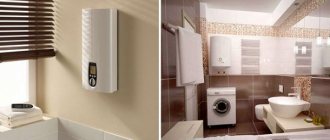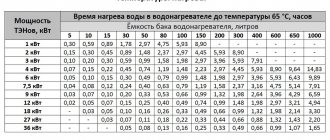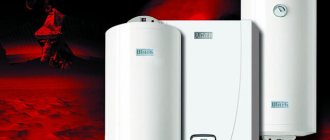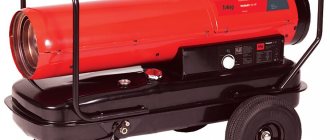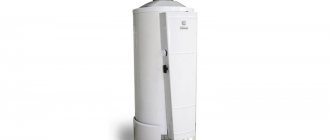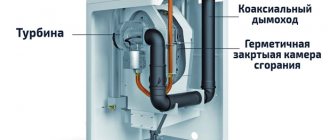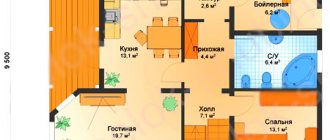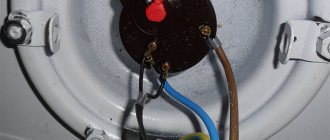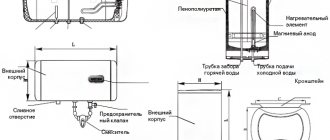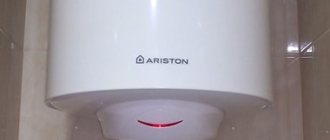The device and the principle of operation of technology
To rationally reduce energy costs, it is worth understanding the design of the water heater. It is designed as a stainless steel or steel tank with a layer of thermal insulation. Magnesium anodes are built into the steel tank to prevent corrosion and electrochemical reactions. A tubular heater with a thermostat is built into the tank. In the lower part of the tank there are pipes for supplying and releasing water. A thermostat and a thermometer are displayed on the front or bottom panel.
The device works as follows:
- Cold water is poured into the container through a hose with safety and return valves.
- The heating element turns on automatically and heats the water.
- When the contents of the tank reach the desired temperature, the heater is turned off using a thermostat.
- In models without tapping, the heating level is maintained in automatic mode - the heating element turns on and off after a certain time.
- By opening the hot water supply tap on the mixer, water is taken from the upper part through a special tube.
Determination of the efficiency of a new water heater
How to start economically and correctly using a new boiler? Experts focus on determining its energy efficiency when purchasing.
General rules
Before purchasing equipment, the user needs:
- compare the energy efficiency of expensive and budget models in the store to establish the payback of the technique;
- to clarify that the energy efficiency class includes efficiency, losses per hour during heating and maintaining temperature, circulation. Information is indicated in the manufacturer's leaflet;
- take into account the capacity of the container, the speed of the heating element, the type of installation to clarify the total costs.
Interesting to know! On European models of boilers, energy efficiency has been indicated since 2013, on American models - since 2009.
Calculation of costs for annual operation
For calculations, you will need information about the energy efficiency class, type and cost of the coolant. Further calculations are performed according to the formula:
- for gas models, the number of days per year is multiplied by energy efficiency and the cost of a cubic meter of gas;
- for electric boilers, the number of days per year is multiplied by the energy efficiency and the cost of kWh.
Interesting to know! The DOE test for water heaters takes into account temperatures cold (15 degrees) and hot (60 degrees) and determines the performance of the device for a family of 3 people as 240 liters per day.
Heating element power as a saving factor
The greater the power of the heating element, the faster the water will heat up. Keep in mind that in houses with a single-phase wiring scheme, from 7 to 10 kW of power are allocated. A productive water heater will lead to an increase in the load on the network, huge energy costs and knocking out circuit breakers.
Extending the life of the boiler
In order to avoid sudden temperature changes (especially for cheap water heaters), it is inappropriate to set too much heat, which over time can cause cracking of the tank walls. Change the magnesium anode periodically (about once a year).
Choosing a quality heating tank
In order for the water heater to work for a long time, when buying, they pay attention to the quality of the model. A good boiler must meet the following requirements:
- Have enough power. In this case, it is important to calculate that it matches the quality of the wiring in the house.New wiring can withstand a load of 6 kW, and the old one - no more than 2.5 kW. They take into account the fact that more powerful models consume more electricity.
- Boilers differ in "stuffing". Cheap ones have glass-ceramic and enamel coating, more expensive ones are made of titanium and stainless steel. But there is one caveat: some users of boilers with a stainless steel tank note the appearance of an unpleasant aftertaste of water.
- The thickness of the tank insulation is at least 35 millimeters. The water heats up faster (less energy consumption) and the temperature stays longer.
- There is overheating protection.
- The degree of protection against moisture and dust (IP) is at least 23, and for a bathroom, where the humidity is high, at least 44.
- There is a frost prevention mode if the device is purchased for a summer residence.
It is important to choose a boiler by volume, depending on the number of people living together. So, for one person, a 30 liter tank is enough.
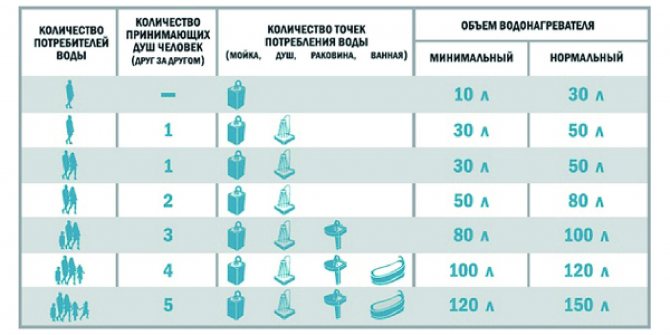
You also need to take into account that the devices are available with wet and dry heating elements. The second is safer, since it excludes the possibility of electric shock.
Timely troubleshooting
You can prevent boiler breakdowns if you regularly carry out preventive inspections. Any malfunctions should be eliminated immediately, without waiting for the water heater to fail. The condition of the magnesium anode and safety valve should be checked annually.
Regular cleaning
Once a year it is necessary to descale the boiler. You can invite the master of the service center or clean it yourself. The water heater is disconnected from the network, water is poured out, the electronic "filling" and the heating element are removed. The heating element is cleaned and installed in place.
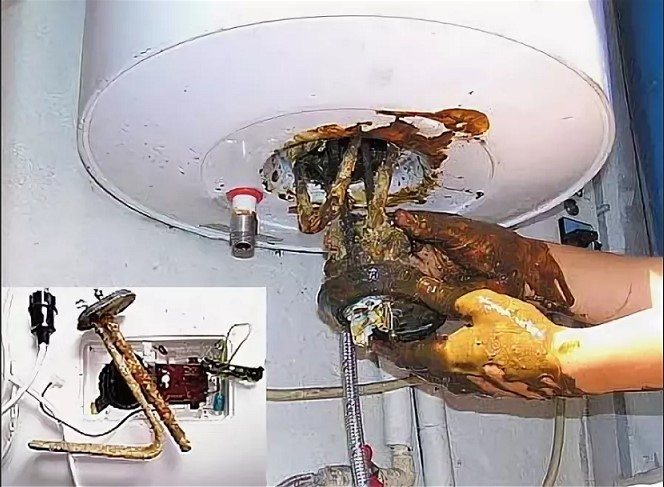

The correct choice of the heater model, reasonable operation, regular cleaning will allow you to use the device for a long time. And if you follow the above recommendations, you can achieve 15-20 percent savings in electricity consumption.
How to use the boiler economically?
It is necessary to save with the included water heater during its operation, and not choose the most budgetary model. Users give many tips on how to really save the electricity consumed on a domestic boiler. Below is the TOP of the most effective ones.
Installation and connection for economical operation
There are some simple tricks:
- selection of a suitable place for installation. The long length of the pipe from the bathtub to the sink results in heat dissipation. In this case, more kilowatts are spent;
- activity setting. You can select the periods of activity and restart of the heating element. It won't save you a lot, but it's a good start;
- preventive cleaning of the heater. After descaling, the heating element will generate a sufficient amount of heat with minimal energy consumption;
- one temperature level. The maximum setting provides quick heating, but increases energy consumption. By selecting a heating program, you can reduce the amount of energy consumed.
Important! In older models of boilers in heating mode, efficiency decreases and they consume more energy.
Reducing hot water consumption
Is it only about energy? You will not understand how to economically use a domestic boiler if you do not calculate the water consumption. To raise the temperature of 1 liter of water, 0.001 kW / h of heater power is needed. But even this is easy to save on.
Scheduled activation
It is worth starting the boiler only when hot water is really required. It is better to wait for the device to heat up than to pay huge bills. The switching schedule depends on the volume of the tank:
- water heaters with a capacity of up to 50 liters can be turned off before leaving the house, and turned on upon returning. The device spends 1-1.5 hours on heating, then it simply keeps the water hot;
- boilers for 80-100 liters take longer to heat up, consume a large amount of energy. It is enough to set the temperature to a minimum and turn on the standby mode.
Advice! Buy and set a timer - it will turn on heating 2 times a day by the selected time.
Preheating
How can you save on a running boiler in winter? At a temperature of water in communications of the central type of 6-10 degrees, more energy is required for heating. To reduce costs, you need to fill a container of 50-100 liters with warm water and put it in the boiler room. It will heat up in 8-10 hours.
Important! The method is suitable only for residents of private houses and involves the use of alternative heat sources.
Methods for installing and connecting Ariston water heaters
The installation and connection of the apparatus must be done by a technician. This is necessary to avoid problems with warranty repairs. In the case of self-assembly, the procedure is as follows:
- Preparation. This stage includes the determination of the place and method of installation, the purchase of dowels, a preliminary calculation of the weight: the mass of the container + water.
- Installation. Mark the place of installation and install the fixing hardware - standard fixing is 2 dowels. The unit must be installed above the mixer, this is necessary for ease of further service and convenient operation. It is easier to install a floor-standing boiler: it is necessary to attach the legs to the hot water equipment.
- Water connection. It is performed only after the water is shut off and the fluid supply pipes are secured with nuts and sealant.
- Checking. If everything is done correctly, the equipment will start heating the water. After that, it must be drained in order to check for leaks.
The Ariston equipment package also includes a safety valve. Most likely, you will have to buy valves, connecting elements, in some cases - fastening accessories.
Each water heater is supplied with instructions, which indicate the nuances of installing the model.
Energy efficient operation of water heaters
To eliminate overpayments for utilities, you need to figure out how to properly and effectively use a household boiler to efficiently save water and electricity. There are several ways.
Wastewater heat recovery
80 to 90% of the hot water energy is discharged into the sewer drain. Installation of the system allows using the heat of the waste liquid to heat the cold one. It is advisable to use 2 types of equipment in apartments and houses:
- with a buffer tank. Justified when using a washing machine or dishwasher. The effluent passes through a spiral tube in the reservoir, and their heat heats the water, which is pushed upwards. The water returns to the boiler in a preheated state;
- without buffer tank. A copper heat exchanger in the form of a spiral is wound on the sewer section. Preheated water is also returned through it.
Important! Depending on the intensity of use, the payback period for such equipment is 2.5-7 years.
Heat traps
When the heater pipes are connected to the top, the water rises and heats the pipes always. Convection loops conduct heat into the air where it is wasted. Installation of anti-convection ducts at the points where the pipeline is connected to the heater will increase the energy efficiency of the boiler.
Heat traps can be made by tying vertical pipes horizontally. To prevent the release of heat, plastic inserts are made at the joints of the pipes and heaters.
Lowering the water temperature in the water heater
There is a program selector on the outside panel. By setting the E (economical) mode, you will get water heating up to 55-60 degrees. The savings consist in increasing the resource of the heating element without consuming energy.
On the LCD panel, Eco mode can be programmed at a desired time.For boilers with mechanical control, just turn the knob.
Savings in the operation of the boiler provides a reduction in utility bills. There are many ways to improve the energy efficiency of your appliance. When choosing a specific option, be guided by the type of water heater and its displacement.
Almost every owner of this device knows how to use the boiler correctly, but the question is how to save energy on the boiler, without breaking the laws, know only a few. In this article, we will tell you how to save on hot water supply, and you will be able to rank yourself among those units of people.
Features of water heaters by type of energy source
According to the energy source, water heaters are:
- Gas.
- Electrical.
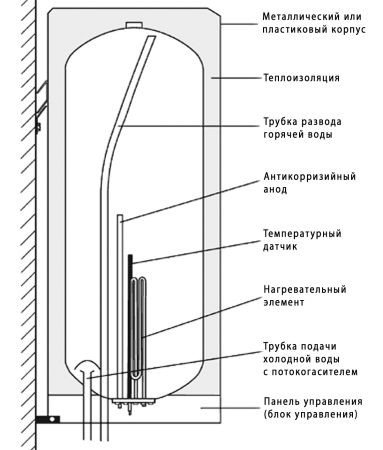

Boiler device diagram.
The consumer properties of these devices are the same, they differ only in the installation conditions. The main feature of operation for devices, subdivided by the type of energy source, is their installation and energy supply. Let's take a look at each of these types in order.
Gas heaters are the most unpretentious of all. The basic rules that need to be followed during the operation and installation of this device are as follows:
- The installation of the device must be carried out as required by the user manual.
- Take care in advance of the presence of a chimney for the removal of exhaust gases.
- The surface on which the device will be mounted must be rigid and solid.
- Be sure to install a non-return valve.
- Check the heater and automation every year.
It will be impossible to use a gas heater in the apartment. Most of all, these products are suitable for country houses that are connected to the main gas supply system.
Electric water heaters are suitable for both an apartment and a house. To extend the life of an electric water heater, you must:
- The installation of the electric water heater should be carried out as required by the manufacturer's instructions.
- An earthed socket must be provided for the boiler.
- Install a non-return valve.
- Do not turn on an empty water heater.
- Do not constantly use the temperature of heating the water in the boiler to the maximum value.
- Perform maintenance annually.
Guided by these rules, you will save the automation and electrical equipment of your devices.
Methods to reduce electricity costs
To do this, you must adhere to the following tips:
- Find the best place for installing the boiler. After all, if too large a pipeline runs to the sink or bath, then the heat will naturally dissipate, forcing you to spend more kilowatts.
- Choose the correct operating mode for the device. To save money, you need to correctly configure the active and inactive periods of the device, namely the heating element, you can save a small amount on kilowatts.
- Carry out preventive cleaning of the heating element (heating element). By cleaning it from scale, you can increase the efficiency of the element, namely, get the same amount of heat with less energy consumption.
By sticking to all these points, you can save a small amount of electricity, which will positively affect your budget.
See also -
How to clean a boiler yourself
We select the right place to install the boiler
When you open a tap with hot water, you will most often have slightly warm water pouring out from there. Why is that? You may ask, since the liquid inside the heat exchanger is hot and there is no doubt about that, however, the boiling water must reach the tap, having previously displaced the cold liquid in the pipe. In a pipe 1 meter long and half an inch in diameter, due to the loss of temperature, it will be necessary to cover the loss of 200 milliliters of fluid.
After the valve on the tap was closed, you lose the same volume of warm liquid, because the "unused" liquid will remain in the pipes until the next opening of the valve. We can conclude that every time you use a tap, your boiler consumes at least 400 milliliters for each running meter of pipe.
This cost can be optimized by reducing the length of the pipeline. Simply put, it is necessary to install the water heater in such a way that it is located in the middle of the kitchen and bathroom, but it is worth noting that it is better to make the kitchen branch shorter than the one that goes to the bathroom. After all, you turn on the tap in the kitchen much more often than in the bathroom.
However, it is not always the "suitable place" that will significantly reduce costs, is ideal from the aesthetic point of view, and even more so from the convenience of use. After all, think for yourself, not everyone will be able to endure a water heater that is corrosive to the eyes, located, for example, in the corridor. Yes, and not every owner of a water heater will dare to install it in an inconvenient place for him.
We select the correct mode of operation of the device
Most often, when the conversation comes to saving electricity among boiler users, they are divided into two camps. The former argue that the boiler must always be connected to the network in order to obtain the necessary hot water at any time. The latter argue that it is necessary turn off the boiler during the inactive stage and only turn on for -5 hours a day in order to heat the water.
So: in this matter, everyone is mistaken. You will in some way not be able to save on electricity by turning off the boiler, brought to the maximum temperature, and accordingly, you will not get any benefit.
Changing the power supply model of the heating element can save energy costs only in the absence of hot water in the device. You don't want to take a cold bath or wash dishes in ice water, do you? You were not counting on such economic benefit.
However, don't be upset. In order to understand how to save on the boiler correctly, it is necessary to recall the Fourier law of thermal conductivity, in which it is interpreted about the relationship between the energy absorbed during heating and the temperature difference of the incoming stream.
From this it follows that the achievement of a minimum difference between the temperature of the liquid that enters the tank and that already there, the less energy is needed in order to heat up the mixed liquid.
Simply put, by lowering the temperature of the boiler from 85-90 degrees to 55-60, you can safely use the boiler around the clock for a flight and save much more energy than constantly turning off the water heater, which worked at maximum. By reducing the temperature to 55-60 degrees, you will significantly slow down the process of scale formation on the heating element, due to a decrease in the thermal power of the device.
Rest mode and boiler operation
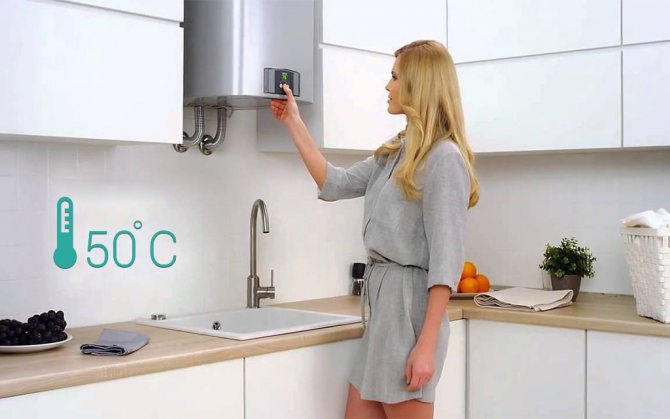

Boilers are not used all the time, so it is advisable to designate periods of operation and downtime. The first start includes filling water to the maximum level and heating up to the maximum mark on the temperature gradation, fixed on the device body. The owner can choose to what temperature the water should be heated: from 35 to 75 degrees. Modern models of heating products are equipped with an additional function "Anti-freeze" - the mechanism maintains the water temperature at 10 degrees with a plus sign.
Aggregate mode setting consists of the following rules:
- Before turning on the tank, assess the filling level, if there is no water, you should not turn on the device, there is a high probability of breakage of the heating element.
- If the temperature is not set to the maximum, you need to rearrange it once every two weeks - boiling water will destroy pathogenic microbes.
- If boilers are purchased for a private house, it will not be superfluous to provide a strainer at the cold water inlet. Water hardness can be reduced by additional cleaning and disposal of salts; this must also be done to extend the life of the unit.
- Once every couple of years, descale the inside of the tank.
A few more words about the operating mode of the device: by regularly switching off and turning on the product or, conversely, leaving it to work for a full day, one can only dream of saving. These two methods do not work the same way. In order to save money, the difference between the liquid entering the boiler and the water supply in the apparatus is important. The smaller it is, the less electricity is needed for heating.
It turns out that it makes sense to set the heating temperature to 55-60 degrees and not turn off the structure day and night.
Consider the process of cleaning the heating element
A contaminated heating element will not be able to operate at its maximum efficiency. Some of the useful energy will be absorbed by the scale. In case of descaling the heating element, you will receive a normally functioning device with its original characteristics.
Step-by-step instructions for cleaning the heating element:
- Drain all the water from the boiler, after shutting off its supply.
- Disconnect the device from the mains, and dismantle the heating element.
- Make a cleaning solution. To prepare it, you will need one and a half liters of water and 15 grams of citric acid.
- Reinstall the already cleaned element.
- Return the water supply and connect the device to the mains.
If you do not want to perform these manipulations on your own, you can contact the specialists who will replace the heating element for 2.5-3 thousand rubles.
In this article, we have described the main methods, how to save energy on the boiler, considered the main points on the rules of operation and maintenance of the device.
See also:
Preparing hot water in a boiler is a very energy-intensive activity. But there are simple ways to reduce your hot water costs.
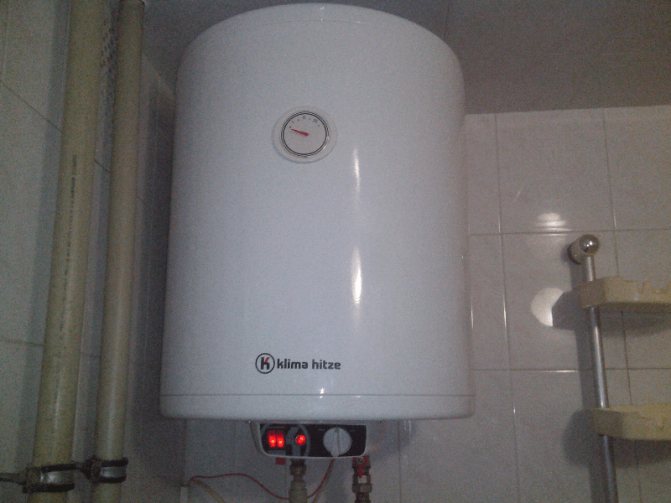

The question of how to save energy on the boiler worries many. It is no secret that any heating device - even a small kettle - consumes a lot of resources, the tariffs for which are very high. What can we say about equipment that is designed for 50, 80 or 100 liters of water. It is clear that a lot of electricity is required to heat such a volume.
Parameters affecting the durability of the boiler
Experts have calculated that the average lifespan of a water heater is about ten years, however, it can fail much earlier. The main reasons for this unscheduled exit:
- The choice of the volume of the storage tank, if it is small, then the boiler will often turn on / off, which will lead to a reduction in the period of operation. The high temperature of water heating, it should not exceed 55 C, with higher heating, the process of scale formation on the walls of the heating elements increases, they overheat and burn out.
- Model quality. When buying, you need to pay attention to the service life of the unit, if the manufacturer has installed it below 7 years, then the boiler is of poor quality and can fail very quickly.
- Cleaning the water heater, you need to periodically clean the internal surfaces of the heater, but do it carefully so as not to damage the internal elements.
- Anode wear, the most common and programmed water heater failure. After all, it is installed to take over the corrosiveness of the boiler environment and save an expensive tank from damage. It must be changed at least once every 2-3 years.
- Violations during installation work. It is not recommended to place the boiler in a humid room and to perform piping of the unit according to a scheme that does not comply with the manufacturer's recommendations.
External casing of water heaters
The protective case, although it plays an auxiliary role, but the overall heating process depends on its performance. The controls and controls are mounted on it. The main criteria for the reliable operation of the water heater:
- Steel inner case with anti-corrosion coating;
- corrosion protection with magnesium anode;
- water pressure control sensor;
- heating elements made of stainless steel;
- stability of incoming current parameters or installation of a stabilizer;
- sensors for monitoring the filling of the tank with water and heating temperature.
Water heater heating element
This is the second most important element in the boiler and it is he who is most susceptible to aggressive wear due to scale deposits. In order to extend the service life of the heating element, and therefore the device as a whole, it will be necessary to periodically remove scale from the internal heating surfaces. The heating element can also burn out due to the poor quality of the electricity parameters, for example, with an increased voltage in the supply network. The user will need to pay attention to this factor and, if it occurs, it is better to install a stabilizer.
When picking up an element, it is recommended to purchase a boiler equipped with stainless steel heating elements. Of the two types "wet" and "dry", it is more promising to choose the latter. In them, the elements are placed in a special container and does not have contact with water, so they are better protected. If possible, it is advisable to purchase a model equipped with 2 heating elements.
Reducing DHW costs
Choosing a location for installation
Selecting the operating mode of the equipment
Cleaning the heating element
In this regard, many are looking for a way to at least slightly reduce consumption so that the availability of hot water in the house does not cost a pretty penny. Fortunately, there are several simple methods for this, which absolutely do not contradict the legislation. To use them, you do not need any specific knowledge or skills to work with electrical engineering - everything is quite simple.
The first thing to do is to make the right choice of location to install your new acquisition. The second is to play a little with the operating modes of the equipment, choosing the most advantageous scheme. The third is to pay close attention to the condition of the heating element. But let's take a closer look at everything.
Choosing a location for installation
As you know, the boiler is connected to the draw-off points - that is, for example, with mixers - using pipes. When you are not using hot water for several hours, when you open the tap, a slightly warm liquid will first pour out, and only then will you get the right temperature. The explanation for this is very simple. The water that was heated by the boiler, but not released through the tap, remains in the section of the pipeline connecting them. During the period of inactivity, it cools down, and when the mixer is opened, it is drained.
Thus, you waste a certain amount of electricity that was wasted on heating this volume, wasted. The longer the pipe leading from the water heater to the nearest draw-off point, the more significant these losses will be. As an approximate figure, you can take 400 ml of water for each meter of the pipeline.
To avoid these, albeit not too large, losses, there is a simple way. Initially, install the boiler so that the pipe section between it and the nearest (or most frequently used) mixer is as short as possible. For example, if a water heater serves both the bathroom and the kitchen, then it is advisable to place it between them, and so that the water path to the second room is shorter - after all, the water is usually turned on there much more often.
